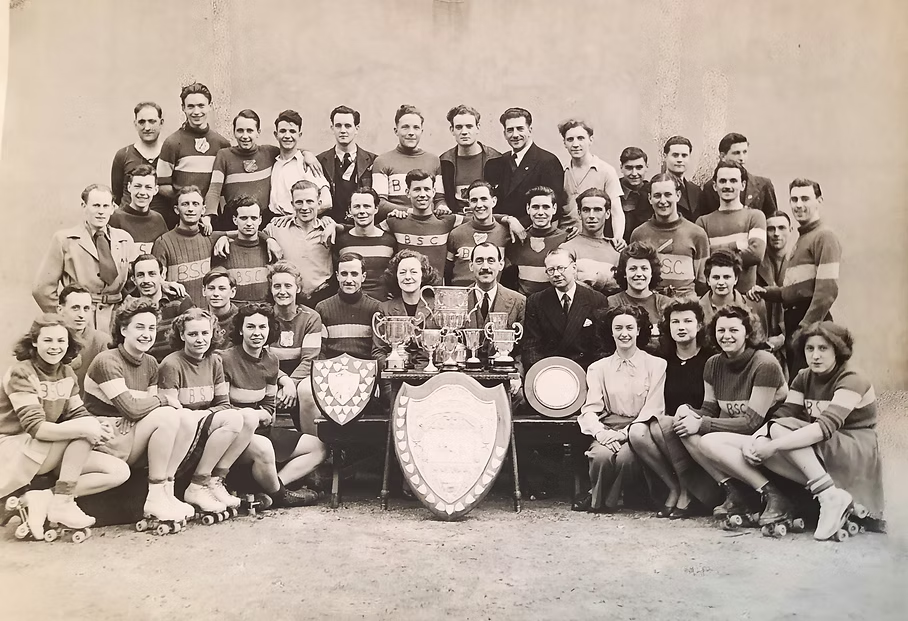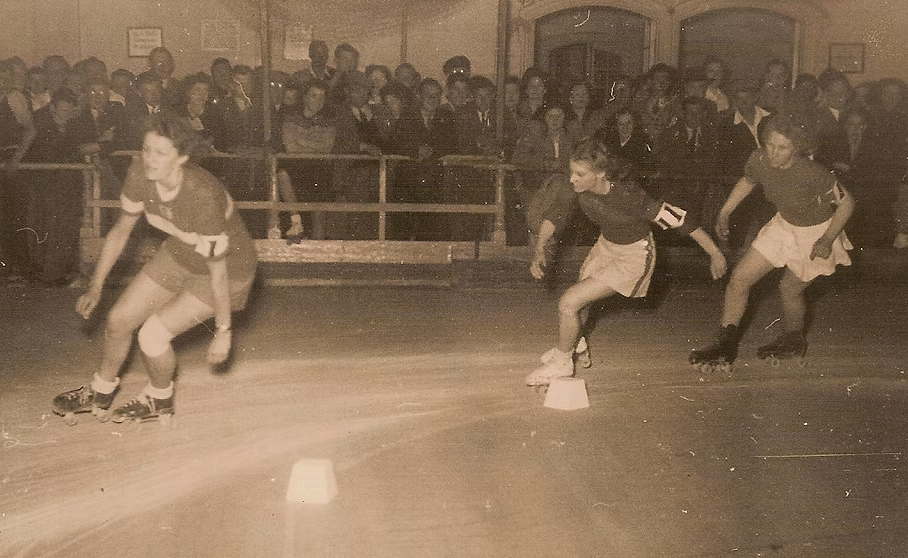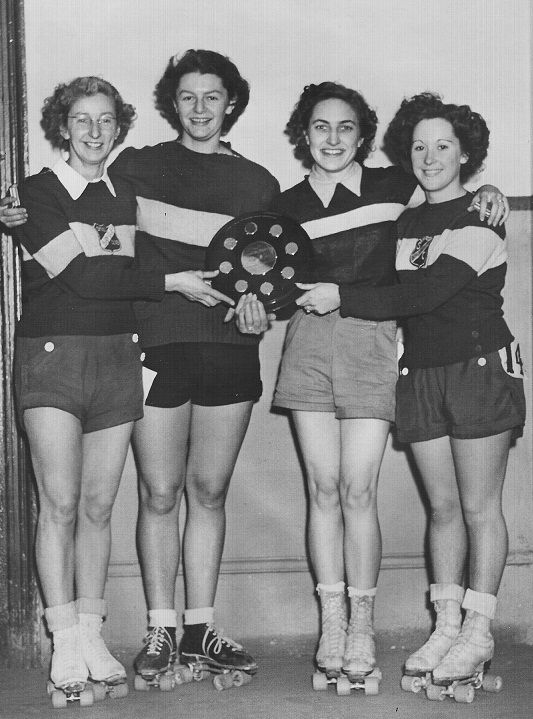LEYENDAS DEL PATINAJE BRITÁNICO

Yvonne Brod
Yvonne Brod was born in London in the early part of 1931 to Simon and Emily Brod (nee Willcox). Her father was Ukrainian by birth having been born in Kiev in 1898, then part of Russia. It is thought that he came to England as a refugee after the first world war. In the early 1920’s he travelled to America but shortly returned on the ‘Olympic’, sister ship to the ‘Titanic’, and eventually settled down in London working as a printer.
Initially, Brod and her parents lived in Grove Gardens near to Regent’s Park, but by the time she was eight the family had moved into a flat, Clive Court, on Maida Vale.
Brod’s first foray into roller skating started with dancing. As a young teenager she joined the Belmar Roller Dance Club which was based at the Cricklewood rink. Brod was considered quite stocky for a roller dancer but despite this she was quite adept at it and it was not uncommon for her to be amongst the medals.

In early 1947, aged just sixteen, she and a number of other skaters from the Cricklewood rink played extras in a roller skating scene in a film called ‘Black Memory’ starring Michael Medwin and Myra O’Connell. (The clip can be found in the ‘Video’ section of the British Skating Legends website for those who are interested).
By December 1947 Brod was now partnered in her dance routines by Russell Matthews. Matthews was also a member of the Broadway Roller Speed Club which was also based at the Cricklewood rink and was seven years Brod’s senior. Together they would continue to feature amongst the dance medals and soon after the couple started courting where Matthews’ influence attracted Brod to speed skating.
In the 1930’s the Broadway club was certainly amongst the top clubs in Great Britain, but almost immediately after the war ended the club cemented itself as the number one club in the country. In 1947 several members of the club attended the inaugural World Roller Skating Congress where Frank Lamb would become the (unofficial) Two Mile World Champion. The club also consisted of internationals Jackie Reeves, Denis Hill and Don Brown, all three multiple British Champions with Hill and Brown also taking world medals throughout their respective careers. Speed skating in general was enjoying a boom period and race entries were at an all-time high for both men and women. With such a pool of talent available to her to train with Brod was showing her prominence very early on.

Our earliest record of Brod racing is on 8th May 1948, when at the age of seventeen she took part in the Half Mile Championship at Herne Bay. She qualified from her heat and in the semi-final came up against Violet Kirby (Herne Bay R.H & R.S.C.). Kirby was an enigma in female speed skating in Great Britain. She had won the trophy on four consecutive occasions, the first being in 1937. In fact, such was her superiority that once racing resumed after the second world war in 1946, she retained her title. In 1947 she had taken time out to have a family which left the door open for June Gillard (Broadway) to be crowned champion, but in 1948 Kirby returned. With a home advantage Kirby won the semi-final, but just six yards behind her came Brod which meant that she too would qualify for the final.
As the last lap unfolded in the final Kirby was again victorious, regaining the title she had first won some eleven years previous. Just behind her was Joyce Robinson (Broadway) and then in third place came Brod. The race was Kirby’s swansong and that meant a changing of the guard was about to take place. There was plenty of women speed skating talent around at that time. In fact, race entries for ladies’ events would often number in excess of thirty, but as the 1947-48 season came to an end and the 1948-49 season started, one skater stood out from the others. That skater was Yvonne Brod.
On 20th January 1949 the Alexandra Palace club hosted the Carlton Shield half mile handicap event. Brod would come home in second place with a handicap of just 10 yards. Almost four seconds ahead of her was Irene Turner (Alexandra Palace) who had started off 55 yards. Brod had made good headway in the race but a gold medal still eluded her. In April, however, that was to change. It was another half mile handicap race, this time for the Anderton Cup. Brod found herself skating from the scratch mark but her natural strength and speed saw her not only qualify for the final, it also allowed her to pick off the skaters ahead of her to come home in first place.
On 23rd April 1949, a week on from her first victory, Brod once again took to the track to compete in the Half Mile British Championship for the George French Challenge Shield. Once again, the event was held on the Herne Bay rink, but this time Brod secured her first British title. She was still only eighteen and the future certainly looked bright for the youngster. Not only was she becoming a success in her speed skating but she was still achieving accolades at dancing with her partner.

In May she returned to the Herne Bay rink and followed up her championship victory by becoming the first recipient of the Vi Kirby Trophy. Having now retired, Kirby had donated a trophy to the National Skating Association (NSA) to be used for a Half Mile Handicap Championship, akin to the Jesson Cup event that the men took part in. Once again, skating from scratch Brod swept all before her.
The following year the Half Mile Championship was run at the Granby Halls rink, Leicester, for the first time. The previous five occasions had been at Herne Bay, a rink that Brod had excelled on. Now it was to be held in Leicester and other skaters felt that this was an opportunity to deliver an upset. By the end of the race, however, Brod had once again asserted herself as the number one female skater in the country and retained her title.
Also, in 1950 the NSA had decided to include an additional female British Championship on the race calendar. Ever since the first ladies British Championship was held in 1927 it had only ever been a single event, the Half Mile Championship. Major Kenneth Beaumont CBE DSO, who had been Vice-President of the NSA since 1939 and Chairman of the NSA Executive Board since 1947, donated a trophy to the Roller Speed Committee that would be used for this new championship, the Quarter Mile.
On 12th February 1950 the inaugural Quarter Mile Championship was held at the Rochester Casino rink. Despite a field of 33 starters such was Brod’s dominance that she became the first British Quarter Mile Champion and added the Beaumont Cup to her ever increasing trophy haul.

On 5th July her mother, Emily, would sadly pass away and still only nineteen Brod would end up carrying out the daily chores whilst her father worked.
For the 1951 (November 1950) Half Mile Championship the event moved to Alexandra Palace. Brod was still the obvious favourite despite there being a record thirty-six entries for the race (a record that still stands to this day incidentally). Brod did not disappoint and would go on to win her third consecutive victory becoming only the second female skater after Violet Kirby to do so on three different tracks.
The Vi Kirby Trophy was held just a few weeks later on 9th December and Brod could only manage third place. Starting again from scratch she was pipped by Pauline ‘Paddy’ Brett (Rochester United) and rising star, Joan Vine (Brixton Falcons) off 40 and 45 yards respectively.
As the 1950-51 season got into full swing questions about Brod’s superiority began to surface. Whilst third place in the Vi Kirby Trophy had not set any alarm bells, after all it was a handicap and relied heavily on the NSA handicapper to get it right, the Quarter Mile Championship in March 1951 did raise a few eyebrows. Brod would fail to retain her title finishing second to Lillian Ashby (Rochester United). Despite the questions, Ashby’s victory was both well deserved and also not entirely unexpected. Ashby was a decent skater and the championship was held on her home track at Rochester Casino, so why shouldn’t she beat Brod? Then came the Sidwell Cup at Herne Bay, a half mile scratch event on a track where Brod had been previously successful. Brod’s strength was her strength preferring half mile events to the short quarter mile sprints, however, she was once again beaten into second place by Ashby.
On 17th November 1951, at the start of the 1951-52 season Brod returned to the Alexandra Palace with the aim of defending her Half Mile Championship, but once again she came up short. This time it was Maureen Stewart (Alexandra Palace) who would take the title, a full 6/10ths of a second ahead of Brod who was catching Stewart in the latter laps. Brod had set the fastest recorded time in this event the previous year but Stewart’s time was a full two seconds faster.

Undaunted, Brod took to the track again on 9th December 1951 in an attempt to regain her Quarter Mile title. She now knew that the cards were stacked against her with defending champion, Lillian Ashby, again having the luxury of the event being held on her home track at the Rochester Casino. However, Brod dug out a performance that would see her once again be crowned British Quarter Mile Champion. It was her fourth and final title and in fact, her very last individual British Championship medal.
A few months later Brod would marry Russell Matthews, her long time fiancé. For a period the couple lived with Brod’s father in the flat in Maida Vale until his death in 1962.
Russell was still a keen racer and Yvonne also continued to compete but now with varying degrees of success. Around the time of her wedding in February 1952 she competed in and won the half mile scratch race for the Christopher Cup at Rochester. 1952 was to be a pivotal year for Brod as in the latter part of the year the Cricklewood rink closed down meaning that she had now lost her training venue. The Broadway club were kindly offered to share the Alexandra Palace rink as a base and so Brod continued to train and compete, but it wasn’t the same. The Cricklewood rink was a simple bus ride up the Edgware Road from Maida Vale, but getting to the Alexandra Palace required a little more effort. A year later and she finished second in the Christopher Cup to her now teammate, Joan Vine, and then on 2nd May 1954 she was again victorious in the event. This time she finished just ahead of Irene Turner (Alexandra Palace) and local girl Josie Agnew (Rochester United). It was to be Brod’s last individual competitive medal.
Brod raced the occasional race throughout the next few years and gained a few relay medals, including a silver in the British Relay Championship of 1956, but on 9th December that year she raced for the Christopher Cup one last time before finally calling it a day. Pat Eason (Birmingham) was the new force in town and with Eason having taken medals at the 1956 World Championships Brod realised that she would never again reach those heights.
Yvonne Brod burst into speed skating at the tender age of just seventeen, taking over from the legend that was Violet Kirby as the number one female speed skater in the country. For a brief period between 1949 and 1951 she was virtually unstoppable. She was as strong as they came and her technical ability and agility gained from her successful roller dancing exploits helped her take on all comers and invariably beat them. In her short time as a speed skater challenges regularly presented themselves to Brod. The early death of her mother and the closing of the Cricklewood rink would undoubtedly have had a disruptive effect on her skating career.
It was also unfortunate for Brod that female international skating did not fully materialise until 1953. Had it done so just a couple of years earlier Great Britain could well have had it’s first (and only) female World Champion, or at least medallist. And on what grounds is that based I hear you ask? Well, consider this, the first British female national team consisted of Pat Kirkham, Doreen Aspley and Marlene Worrall, all from Birmingham and none of whom would ever win a national title. Kirkham would finish fourth and Aspley fifth in the World Championships in Italy in 1953. In 1954 Joan Rawlings (nee Vine) would bring home a bronze medal, the first ever non-Italian woman to take a medal at a World Championships. Rawlings would also fail to be crowned British Champion. Yvonne Brod was four times a British Champion when the number of skaters racing were at record levels.
After hanging up her skates Brod was rarely seen around a rink. The closing of the Cricklewood rink did little to help that. Her priorities changed and she concentrated on her family, raising two sons with her husband Russell. Skating connections were never far away, though, as in 1964 the couple are found living in the annexe of a house owned by Gordon Brind, a fellow Broadway skater of the 1940’s and 50’s, but as time went on her achievements were talked about less and less until they were eventually all but forgotten.
Russell died in 1995 and Yvonne passed away in 2012, a year after British Skating Legends became a ‘thing’. She would never come to see her exploits written down and resurface for all to read about but believe me when I say that for a period of three or four years she was top of the tree domestically when British female speed skating was at its peak.

Prominent female skater of the Broadway club in the 1940's and 50's